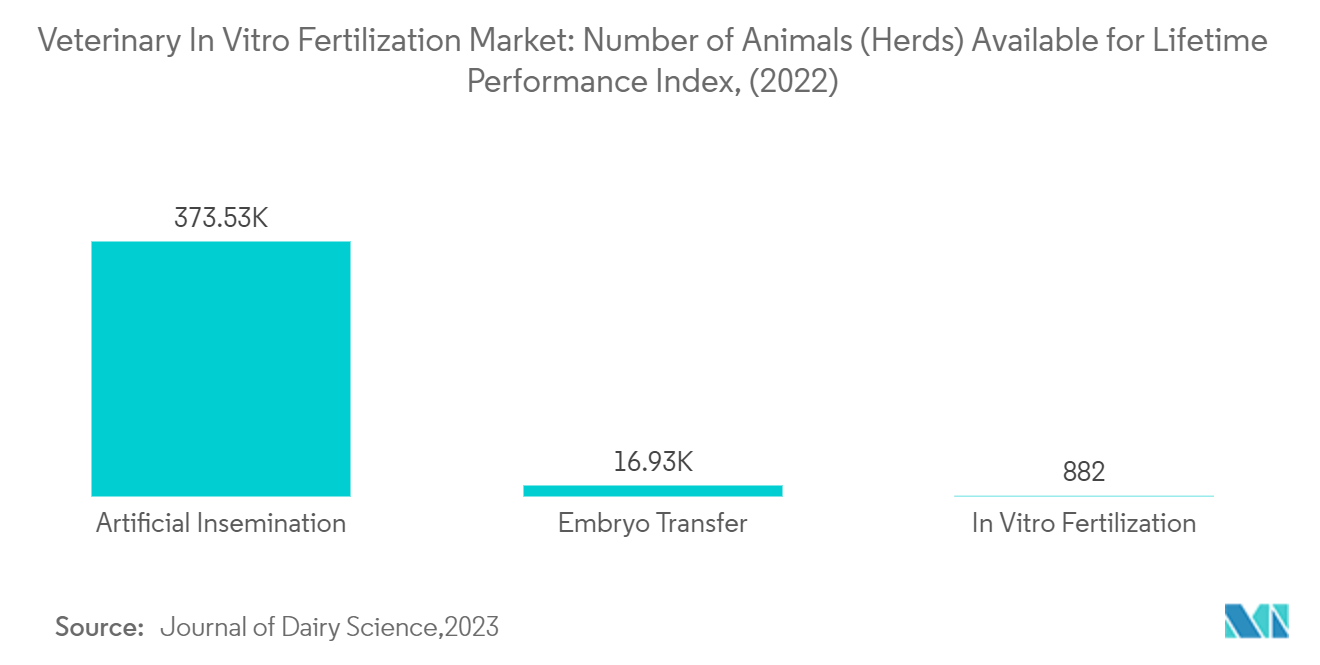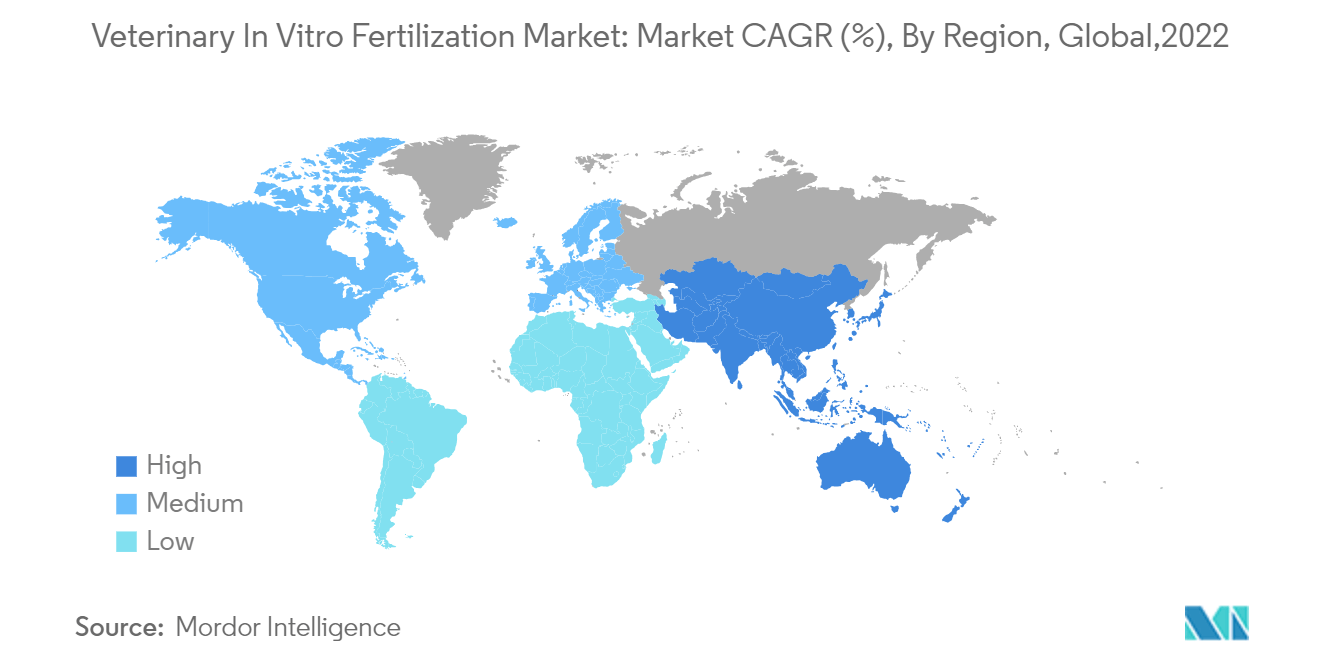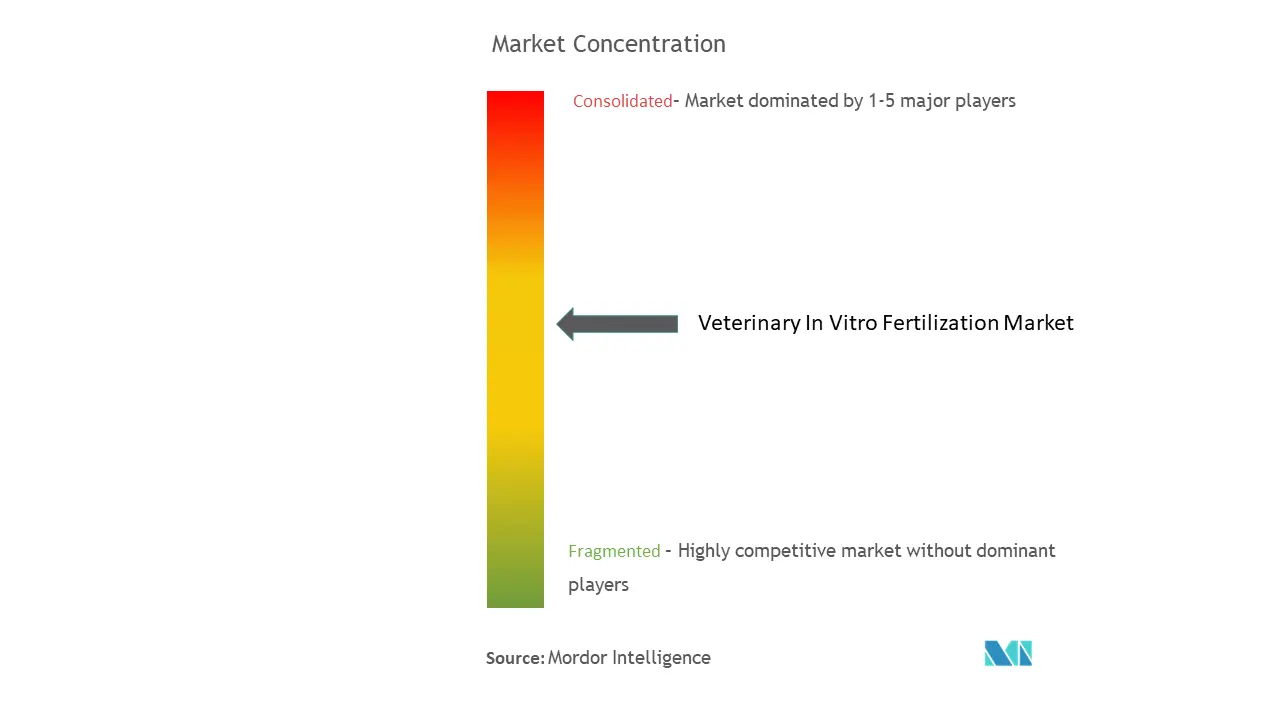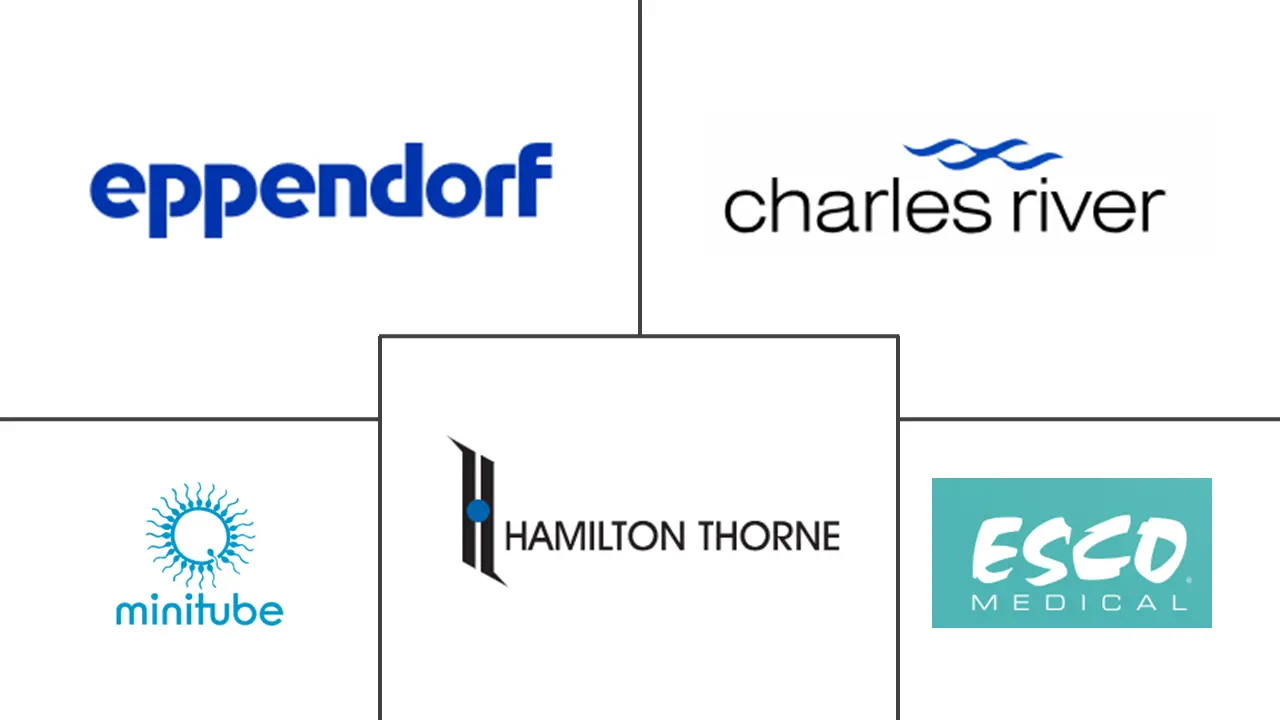Veterinary In Vitro Fertilization Market Size and Share

Veterinary In Vitro Fertilization Market Analysis by Mordor Intelligence
The Veterinary In Vitro Fertilization Market size is estimated at USD 1.60 billion in 2025, and is expected to reach USD 2.04 billion by 2030, at a CAGR of 5% during the forecast period (2025-2030).
The veterinary in vitro fertilization (IVF) market encountered significant challenges and opportunities during the COVID-19 pandemic. The global supply chain disruption impacted the availability and transportation of essential IVF materials and equipment. This led to operational inefficiencies, increased costs, and delays in project timelines of in-vitro fertilization. Pet owners and livestock breeders, facing financial uncertainties, began perceiving advanced reproductive technologies like IVF as an optional service, potentially leading to a decline in demand for veterinary services and influencing the overall dynamics of the IVF market. However, the pandemic has also underscored the significance of genetic diversity and disease resistance in animal populations. IVF offers a strategic solution to enhance genetic diversity by facilitating controlled breeding practices. Through assisted reproductive technologies like IVF, managing and preserving genetic variability within animal populations becomes possible. This realization drives an increased interest in advanced reproductive technologies such as IVF for safeguarding and enhancing desirable animal genetic traits. In February 2021, Animal Frontiers published that capacity-building programs in animal breeding have had challenges due to restrictions, leading to the rescheduling of most programs during a pandemic.
The post-pandemic era presents opportunities for the veterinary IVF market to rebound and grow. As economies recover, increased investment in research and development may lead to technological advancements and the introduction of more cost-effective solutions. Moreover, the increased awareness regarding the importance of animal health and genetics stimulates renewed interest in advanced reproductive technologies, potentially driving market growth. For instance, in April 2023, Vytelle, LLC. announced USD 20 million in funding for accelerating genetic progress in cattle.
Further, increasing demand for high-quality breeding and advancement in reproductive technology are among the significant factors driving the growth of the veterinary in vitro fertilization market. IVF allows for precision breeding by enabling the selection and propagation of specific genetic characteristics, leading to animals with superior traits such as enhanced disease resistance, improved productivity, and desirable physical attributes. For instance, in December 2021, the Journal of Dairy Science published an article stating that assisted reproductive technologies can contribute to accelerated genetic gain by allowing more offspring to be produced from genetically elite dams.
Moreover, advancements in reproductive technology are also influencing the growth of the in vitro veterinary fertilization market. Technological progress helps reshape and expand the landscape of veterinary-assisted reproduction, presenting breeders and researchers with newfound possibilities and efficiencies. Intracytoplasmic sperm injection (ICSI) proves a precious technique in case of male infertility or challenges associated with conventional insemination in certain species. Furthermore, advancements in imaging technology, such as time-lapse microscopy, facilitate the real-time monitoring of embryo development. For instance, in May 2023, Improve International published that embryo production and transfer technologies allow breeders and vets to increase their herds' genetic improvement rate. In July 2023, MDPI published that over the past 40 years, in vitro embryo production (IVEP) has developed significantly, allowing an increase in the reproductive efficiency of animals with superior genetic merit and the maintenance of the population of endangered species.
Thus, increasing demand for high-quality breeding and advancement in reproductive technology drive the growth of the veterinary in-vitro fertilization market. However, the high cost associated with technology will be expected to restrain the market growth over the forecast period.
Global Veterinary In Vitro Fertilization Market Trends and Insights
Instruments Segment is Expected to Witness Significant Growth Over the Forecast Period
The ongoing development of laboratory equipment used for veterinary in vitro fertilization is one of the major driving factors for the segment market. Instruments like micromanipulators, precision pipettes, and incubators are crucial components of the invitro fertilization workflow. Technological advancements in these instruments enable practitioners to handle gametes and embryos with unparalleled precision, ensuring optimal conditions for successful fertilization and embryo development. For instance, in October 2022, Cureus published that the revolutionary new IVF lab-on-a-chip concept could transform in vitro fertilization by automating nearly all necessary steps in a single system.
Moreover, the growth of the instruments segment is further fueled by the increasing demand for automation and robotics in veterinary IVF laboratories. Automated systems streamline workflows, reduce errors, and enhance the reproducibility of IVF procedures. These technological advancements improve efficiency and contribute to the scalability and accessibility of veterinary IVF technology. For instance, time-lapse microscopy allows real-time observation of embryo kinetics, enabling practitioners to select the most viable embryos for transfer.
Therefore, the ongoing development of laboratory equipment and increasing demand for automation and robotics in veterinary IVF laboratories are some of the factors expected to drive the segment's growth in the forecast period.

North America is Expected to Dominate the Veterinary In Vitro Fertilization Market
The increasing demand for advanced breeding practices and genetic improvement in the North American livestock market is a significant factor driving the growth of the veterinary in vitro fertilization market. Livestock breeders in the region increasingly recognize the economic importance of leveraging IVF technologies to enhance genetic traits, improve productivity, and expedite the genetic progress of herds. This increased awareness and adoption of IVF, resulting in segment growth. Furthermore, the region reflects a strong culture of responsible pet ownership and a willingness to invest in advanced reproductive technologies. Pet owners in the area actively seek specific traits in their companion animals, and IVF serves as a precise and effective method for achieving these desired genetic outcomes. For instance, according to the Government of Alberta, around 60% of the Mexican territory is dedicated to livestock activities, and there are more than 3 million livestock production units in which around 53% of the bovine breeders use artificial insemination and 18% use embryo transfers.
The presence of leading companies and research institutions also influences the region's growth. These entities actively contribute to innovation in veterinary IVF, pioneering state-of-the-art techniques and continually refining procedures. The collaborative approach between academic research institutions and market leaders drives a dynamic environment, leading to the evolution of veterinary IVF technologies.
Therefore, advanced breeding practices, genetic improvement, and the concentration of leading companies and research institutions are significant driving factors influencing the growth of the North American region.

Competitive Landscape
The veterinary in vitro fertilization market is semi-consolidated in nature as less number of players occupy a moderate level of market share. The competitive landscape includes an analysis of a few international as well as local companies that hold market shares and are well-known, including Esco Medical., Minitube Group, Eppendorf SE, Hamilton Thorne Inc., and Charles River Laboratories.
Veterinary In Vitro Fertilization Industry Leaders
-
Esco Medical.
-
Minitube Group
-
Eppendorf SE
-
Hamilton Thorne Inc.
-
Charles River Laboratories.
- *Disclaimer: Major Players sorted in no particular order

Recent Industry Developments
- October 2023: Hamilton Thorne Ltd. announced the acquisition of Gynétics Medical Products N.V. The acquisition helped strengthen the company footprint in consumables within the Assisted Reproductive Technology market
- April 2023: Esco Medical announced that it selected Fairtility's CHLOE EQ as an AI decision support tool for MIRI time-lapse incubators as it was expected to ease the workflow of embryologists, increase accuracy, and streamline communication between IVF practitioners, clinic staff, and prospective parents.
Global Veterinary In Vitro Fertilization Market Report Scope
Veterinary in-vitro fertilization is a reproductive technique applied in animals to achieve fertilization outside the organism's body. The technique is used to overcome fertility challenges, preserve genetic diversity, and optimize breeding programs, especially when mating is impractical.
The veterinary in-vitro fertilization market is segmented into product types, techniques, end-user, and geography (North America, Europe, Asia-Pacific, Middle East and Africa, and South America). By product type, the market is segmented into instruments, reagents/consumables, and services. By technique, the market is segmented into embryo transfer, artificial insemination (AI), and other techniques. Other techniques include intracytoplasmic sperm injection, zygote intra-fallopian transfer (ZIFT) & gamete intra-fallopian transfer (GIFT). By end user, the market is segmented into veterinary hospitals, fertility clinics, and other end users. Other end-users include research laboratories and cryobanks. By geography, the market is segmented into North America, Europe, Asia-Pacific, the Middle East and Africa, and South America.
For each segment, the market sizing and forecasts have been done on the basis of value (USD).
| Instruments |
| Reagents/Consumables |
| Services |
| Embryo Transfer |
| Artificial Insemination (AI) |
| Other Techniques |
| Veterinary Hospitals |
| Fertility Clinics |
| Other End-Users |
| North America | United States |
| Canada | |
| Mexico | |
| Europe | Germany |
| United Kingdom | |
| France | |
| Italy | |
| Spain | |
| Rest of Europe | |
| Asia-Pacific | China |
| Japan | |
| India | |
| Australia | |
| South Korea | |
| Rest of Asia-Pacific | |
| Middle East and Africa | GCC |
| South Africa | |
| Rest of Middle East and Africa | |
| South America | Brazil |
| Argentina | |
| Rest of South America |
| By Product Type | Instruments | |
| Reagents/Consumables | ||
| Services | ||
| By Technique | Embryo Transfer | |
| Artificial Insemination (AI) | ||
| Other Techniques | ||
| End-User | Veterinary Hospitals | |
| Fertility Clinics | ||
| Other End-Users | ||
| Geography | North America | United States |
| Canada | ||
| Mexico | ||
| Europe | Germany | |
| United Kingdom | ||
| France | ||
| Italy | ||
| Spain | ||
| Rest of Europe | ||
| Asia-Pacific | China | |
| Japan | ||
| India | ||
| Australia | ||
| South Korea | ||
| Rest of Asia-Pacific | ||
| Middle East and Africa | GCC | |
| South Africa | ||
| Rest of Middle East and Africa | ||
| South America | Brazil | |
| Argentina | ||
| Rest of South America | ||
Key Questions Answered in the Report
How big is the Veterinary In Vitro Fertilization Market?
The Veterinary In Vitro Fertilization Market size is expected to reach USD 1.60 billion in 2025 and grow at a CAGR of 5% to reach USD 2.04 billion by 2030.
What is the current Veterinary In Vitro Fertilization Market size?
In 2025, the Veterinary In Vitro Fertilization Market size is expected to reach USD 1.60 billion.
Who are the key players in Veterinary In Vitro Fertilization Market?
Esco Medical., Minitube Group, Eppendorf SE, Hamilton Thorne Inc. and Charles River Laboratories. are the major companies operating in the Veterinary In Vitro Fertilization Market.
Which is the fastest growing region in Veterinary In Vitro Fertilization Market?
Asia Pacific is estimated to grow at the highest CAGR over the forecast period (2025-2030).
Which region has the biggest share in Veterinary In Vitro Fertilization Market?
In 2025, the North America accounts for the largest market share in Veterinary In Vitro Fertilization Market.
What years does this Veterinary In Vitro Fertilization Market cover, and what was the market size in 2024?
In 2024, the Veterinary In Vitro Fertilization Market size was estimated at USD 1.52 billion. The report covers the Veterinary In Vitro Fertilization Market historical market size for years: 2019, 2020, 2021, 2022, 2023 and 2024. The report also forecasts the Veterinary In Vitro Fertilization Market size for years: 2025, 2026, 2027, 2028, 2029 and 2030.
Page last updated on:
Veterinary In Vitro Fertilization Market Report
Statistics for the 2025 Veterinary In Vitro Fertilization market share, size and revenue growth rate, created by Mordor Intelligence™ Industry Reports. Veterinary In Vitro Fertilization analysis includes a market forecast outlook for 2025 to 2030 and historical overview. Get a sample of this industry analysis as a free report PDF download.



